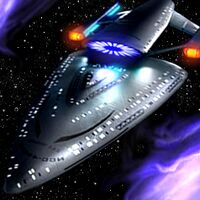Meredith Class
| Meredith-class | |

| |
| Affiliation: | LoDona Starfleet |
| Type: | Heavy cruiser |
| Length: | 1500 meters |
| Beam: | 750 meters |
| Height: | 300 meters |
| Decks: | 70 |
| Crew: | 8,600 - 15,000 |
| Maximum Cruising Speed: | Warp 9 |
| Armament (standard): | Phaser Arrays (360 coverage), 2 forward Photon torpedo launchers, 1 aft Photon torpedo launchers, 3 forward Quantum torpedo launchers, 2 aft Quantum torpedo launchers |
| Defenses: | Deflector shields |
General Overview
This design of ship utilizes three warp cores, one is dedicated to the warp drive, one to the defense system and the third is usually in a state of minimal use, but can be powered up to complement plasma generation. The technicians found that even with all three warp cores working to power the warp engines, increase in speed was not detectable just before the PTCs (Power Transfer Conduits) destroyed themselves!
Previous to 2404, to achieve the emergency speed of warp 6, two of the Warp Cores had to be placed at 100% and power transferred to the nacelles. It is estimated that 10 minutes later, the PTCs would collapse. The third was be placed in operational mode and used at the discretion of the Commanding Officer.
This class was heavily upgraded late in 2404 after extensive field tests of her systems. The vessel had proved over powered and yet was suffering greatly from inefficiencies in her EPS distribution systems, making it hard to achieve full potential.
After many discussions on how to increase her warp speed and weapons systems, several breakthroughs were made and her EPS distribution system was re designed to handle the extra load. In real terms this has increased her operational efficiency by over 200 percent now increasing her maximum warp speed to Warp 9. The addition of the newer higher power EPS Conduits has allowed her to have a new, additional, high powered, phaser arrays.
In case of dire emergency, there is the DBM (Detachable Bridge Module), for essential personnel. The DBM is equipped with an extensible warp nacelle enabling quick getaway.
Utilizing the power surplus of the ship and, given her size, the crew makes more use of site to site transporters as well as the impressive turbolift system.
Cargo Bay 3 is usually reserved for transporting Starbase Modules, when this is not the case, holoemitters can transform part or the entire bay into any customization required by the Commanding Officer and the Mission.
Class History
Technical Data
Command and control systems
Captain's Ready Room
Propulsion systems
- Warp Drive System
- Type : Mark IV Warp Drive
- Power : Three (3) Matter/Antimatter cores with Triad Reactant Injector System (TRIS)
- Nacelles : 2
- Normal Cruising Speed : Warp 7
- Maximum rated speed for 26 hours : Warp 8
- Emergency Speed : 9 (auto shutdown after 30 minutes)
- Impulse Drive Systems
- Type : Type II Hyper Impulse Propulsion System (HIPS)
- Power : Deuterium
- No. Engines : 3
Tactical systems
- Phaser Type : Mark X
- Phaser locations : Phaser Strips are located in all areas, these are complemented with rotating phaser turrets in several locations. Giving the ship true all round phaser coverage.
- Photon Launcher Locations : 2 Fore, 1 Aft
- Photon Complement : 200
- Quantum Launcher Locations : 3 Fore, 2 Aft
- Quantum Complement (MkII - Capable of pattern and independent firing) : 400
- Tractor Beams : 1 Fore, 2 Aft
Deflector shields
- Primary Shields : Auto-modulated high capacity regenerative shield system.
- Secondary Shields : Standard Mark XI Shields.
- Hull Armour : Neutronium
Transporter Systems and Sensors
- Transporter Systems
- Standard (8 Man) : 15
- Combat (6 Man) : 7 (All on Marine Deck/Section)
- Medical (4 Man) : 2 (One in each Med Section)
- Small Cargo (12 Man Equivalent) : 25 (2 in each Small Cargo Bay, 1 in each Large Cargo Bay)
- Large Cargo (30 Man Equivalent) : 5 (1 in each Large Cargo Bay)
- Sensors
- Long Range Sensors : 35 Light Year Max Range.
- Takes 1 minute/per light year for intensive scan
- Takes 1 second/per light year for standard scan
- General scan is almost instant up to maximum range.